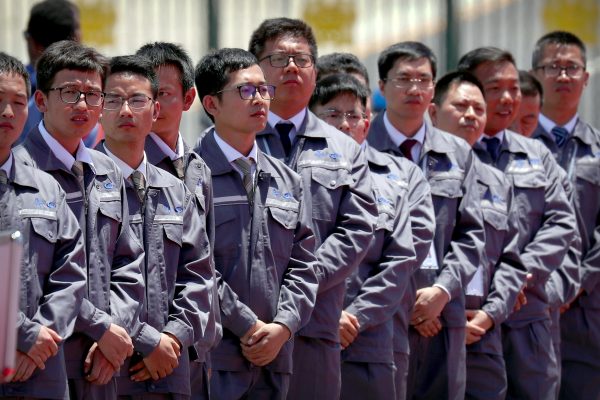CIDCA was designed to meet three objectives: to ‘give full play to foreign aid as a key means of major-country diplomacy’, to ‘enhance strategic planning and coordination of foreign aid’, and to ‘better serve the country’s overall diplomatic layout and the Belt and Road Initiative (BRI)’. The messages are clear. China will use foreign aid as a diplomatic tool and to facilitate implementation of the BRI — President Xi Jinping’s signature project.
As Chinese aid is fragmented, CIDCA will focus on enhancing aid planning, coordination and monitoring. CIDCA’s internal structure reflects this aim. It comprises seven departments, including specific divisions devoted to policy and planning, supervision and evaluation, and international cooperation.
But a comparison of China’s old and new aid systems and their senior management teams suggest aid coordination will continue to be difficult.
There are no significant structural changes between the previous aid system, led by the ministries of commerce (MOFCOM) and foreign affairs (MFA), and the new CIDCA-led system. Under the new system, CIDCA sits beside the same entities and government agencies that governed the previous system and complicated aid management. CIDCA will play a major role in aid planning and monitoring but project implementation remains in the hands of these other organisations.
Being a vice-ministerial level agency, it will also be difficult for CIDCA to coordinate with the other ministerial level organisations during times of disagreement. In particular, CIDCA could face strong challenges from the previous leaders, MOFCOM and MFA.
Although MOFCOM lost overall control of Chinese foreign aid, it retains considerable influence. Primarily, MOFCOM’s affiliates remain the implementing arms of Chinese aid. The Agency for International Economic Cooperation manages China’s turn-key projects and technical cooperation. The China International Centre for Economic and Technical Exchanges is responsible for in-kind donations. The Academy for International Business Officials is tasked with China’s fast-growing training projects.
In China’s diplomatic missions overseas, the Economic and Commercial Counsellor’s Offices are also branches of MOFCOM. Officials from these offices will oversee Chinese aid projects on the ground. MOFCOM further supervises the China Academy of International Trade and Economic Cooperation, a think-tank that provides intellectual support to the Chinese government on trade and aid issues. Being aid contractors, it is not surprising that China’s state-owned enterprises will also continue to enjoy close relations with MOFCOM.
MOFCOM’s Department of Foreign Aid — previously in charge of Chinese foreign aid — has moved to become the backbone of CIDCA. This department has 50–60 staff, the largest concentration of aid technocrats in China, and accounts for about two thirds of CIDCA personnel. Furthering the Ministry of Commerce’s influence, a deputy director of CIDCA is also from MOFCOM.
Meanwhile, the MFA has more power on aid management. As aid is expected to support China’s big-power diplomacy, MFA officials and Chinese ambassadors overseas will have more influence on aid decision-making. About twenty MFA officials have also been transferred to work in CIDCA, making MFA the second largest source of CIDCA staff following MOFCOM.
In terms of the chain of command, CIDCA reports to Yang Jiechi and Wang Yi, China’s two top diplomats representing the Party and the Government respectively. Yang is the director of the Party’s Office of Foreign Affairs and former MFA minister. Wang is incumbent Foreign Minister and State Councilor.
The formation of CIDCA’s management team also reveals potential challenges for the organisation’s operation. To the surprise of many Chinese aid analysts and MOFCOM officials, Wang Xiaotao was appointed the first director. Wang was a former vice minister at China’s National Development and Reform Commission (NDRC) and worked there for three decades. His appointment is largely a compromise between MOFCOM and MFA. But as NDRC is in charge of planning China’s macroeconomic policies and coordinating BRI, Wang could be expected by Beijing to enhance Chinese aid planning and BRI implementation.
Similarly, CIDCA’s three deputy directors have no aid-related work experience. Zhang Maoyu spent thirty years with the China National Intellectual Property Administration, an organisation that has little to do with foreign aid. Zhou Liujun was director-general of MOFCOM’s Department of Trade in Services and Commercial Services. He is MOFCOM’s representative in CIDCA. The third deputy director, Deng Boqing, is MFA’s representative. Boqing was a career diplomat and China’s former ambassador to Dominica and Nigeria.
The lack of aid experience in CIDCA’s management team may negatively impact China’s new aid program. Inter-ministerial coordination will remain a major challenge. While the creation of CIDCA may attempt to improve Chinese aid delivery, a structural analysis suggests little about the country’s aid delivery will change under the new system.
Dr Denghua Zhang is a research fellow at ANU’s Department of Pacific Affairs. His research areas include Asian powers in the Pacific, international relations and development studies.

